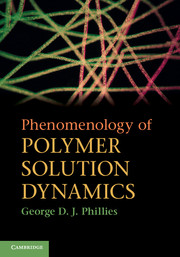Book contents
- Frontmatter
- Contents
- Preface
- 1 Introduction
- 2 Sedimentation
- 3 Electrophoresis
- 4 Quasielastic light scattering and diffusion
- 5 Solvent and small-molecule motion
- 6 Segmental diffusion
- 7 Dielectric relaxation and chain dimensions
- 8 Self- and tracer diffusion
- 9 Probe diffusion
- 10 Dynamics of colloids
- 11 The dynamic structure factor
- 12 Viscosity
- 13 Viscoelasticity
- 14 Nonlinear viscoelastic phenomena
- 15 Qualitative summary
- 16 Phenomenology
- 17 Afterword: hydrodynamic scaling model for polymer dynamics
- Index
- References
6 - Segmental diffusion
Published online by Cambridge University Press: 05 August 2012
- Frontmatter
- Contents
- Preface
- 1 Introduction
- 2 Sedimentation
- 3 Electrophoresis
- 4 Quasielastic light scattering and diffusion
- 5 Solvent and small-molecule motion
- 6 Segmental diffusion
- 7 Dielectric relaxation and chain dimensions
- 8 Self- and tracer diffusion
- 9 Probe diffusion
- 10 Dynamics of colloids
- 11 The dynamic structure factor
- 12 Viscosity
- 13 Viscoelasticity
- 14 Nonlinear viscoelastic phenomena
- 15 Qualitative summary
- 16 Phenomenology
- 17 Afterword: hydrodynamic scaling model for polymer dynamics
- Index
- References
Summary
Introduction
This chapter considers polymer segmental diffusion, the motions of small portions of a polymer relative to the chain as a whole. Studies of motions of short sections of polymer molecules should be seen as being complementary to studies of the motions of small molecules through polymer solutions, as described in Chapter 5. Localmotions of polymer chains on distance scales comparable to q−1 contribute to the polymer dynamic structure factor S(q, t), as discussed in Chapter 11. Important experimental techniques sensitive to segmental motion include depolarized light scattering, time-resolved optical scattering, and nuclear magnetic resonance, as treated in the next three sections.
Depolarized light scattering
The molecular basis for depolarized light scattering by model molecules that resemble polymers was described by Patterson and Carroll(1,2), who discuss intensities and linewidths for depolarized light scattering modes and their relationship to orientation fluctuations. Depolarized light scattering is in part sensitive to local chain motions and in part sensitive to whole-chain motions, as shown by the behavior of the VH spectrum.
The molecular weight dependence of the VH spectrum for low-molecular-weight polymers was found by Lai, et al.(3), who examined concentrated (550 g/l) polystyrenes (9.1 and 18.1 kDa) in cyclohexane. The VH spectrum was dominated by a singlemodewhose relaxation time is independent of polymermolecularweight and scattering angle. Lai, et al. also saw the tail of a very fast mode whose relaxation time distribution was not fully resolved. A dominant mode with these properties is reasonably interpreted as being created by segmental motions that reorient modest portions of a much longer chain.
- Type
- Chapter
- Information
- Phenomenology of Polymer Solution Dynamics , pp. 116 - 133Publisher: Cambridge University PressPrint publication year: 2011

